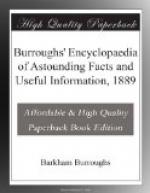A sensible suggestion is made in regard to the finish in necks of dresses for morning wear. Plain colors have rather a stiff appearance, tulle or crepe lisse frilling are expensive and frail, so it is a good idea to purchase a few yards of really good washing lace, about an inch and a half in depth; quill or plait and cut into suitable lengths to tack around the necks of dresses. This can be easily removed and cleaned when soiled. A piece of soft black Spanish lace, folded loosely around the throat close to the frillings, but below it, looks very pretty; or you may get three yards of scarf lace, trim the ends with frillings, place it around the neck, leaving nearly all the length in the right hand, the end lying upon the left shoulder being about half a yard long. Wind the larger piece twice around the throat, in loose, soft folds, and festoon the other yard and a half, and fasten with brooch or flower at the side.—Philadelphia Times.
DISCOVERY OF GOLD IN CALIFORNIA.
It was on the 19th day of January, 1848, that James W. Marshall, while engaged in digging a race for a saw-mill at Coloma, about thirty-five miles eastward from Sutter’s Fort, found some pieces of yellow metal, which he and the half-dozen men working with him at the mill supposed to be gold. He felt confident that he had made a discovery of great importance, but he knew nothing of either chemistry or gold-mining, so he could not prove the nature of the metal nor tell how to obtain it in paying quantities. Every morning he went down to the race to look for the bits of metal; but the other men at the mill thought Marshall was very wild in his ideas, and they continued their labors in building the mill, and in sowing wheat and planting vegetables. The swift current of the mill-race washed away a considerable body of earthy matter, leaving the coarse particles of gold behind; so Marshall’s collection of specimens continued to accumulate, and his associates began to think there might be something in his gold mines after all. About the middle of February, a Mr. Bennett, one of the party employed at the mill, went to San Francisco for the purpose of learning whether this metal was precious, and there he was introduced to Isaac Humphrey, who had washed for gold in Georgia. The experienced miner saw at a glance that he had the true stuff before him, and, after a few inquiries, he was satisfied that the diggings must be rich. He made immediate preparation to visit the mill, and tried to persuade some of his friends to go with him; but they thought it would be only a waste of time and money, so he went with Bennett for his sole companion.




